Emergent Literacy: A Study on the Development of Reading, Writing, and Drawing Skills in Children
VerifiedAdded on 2023/06/04
|12
|2735
|198
AI Summary
This study explores the emergent literacy of children aged 3-5 years through learning activities such as painting, storytelling, and counting. The role of the instructor in developing emergent literacy is analyzed. The study aims to demonstrate the ability and the skill of the child to learn, read, write and draw for the first time. Subject: Education, Course Code: N/A, Course Name: N/A, College/University: N/A
Contribute Materials
Your contribution can guide someone’s learning journey. Share your
documents today.
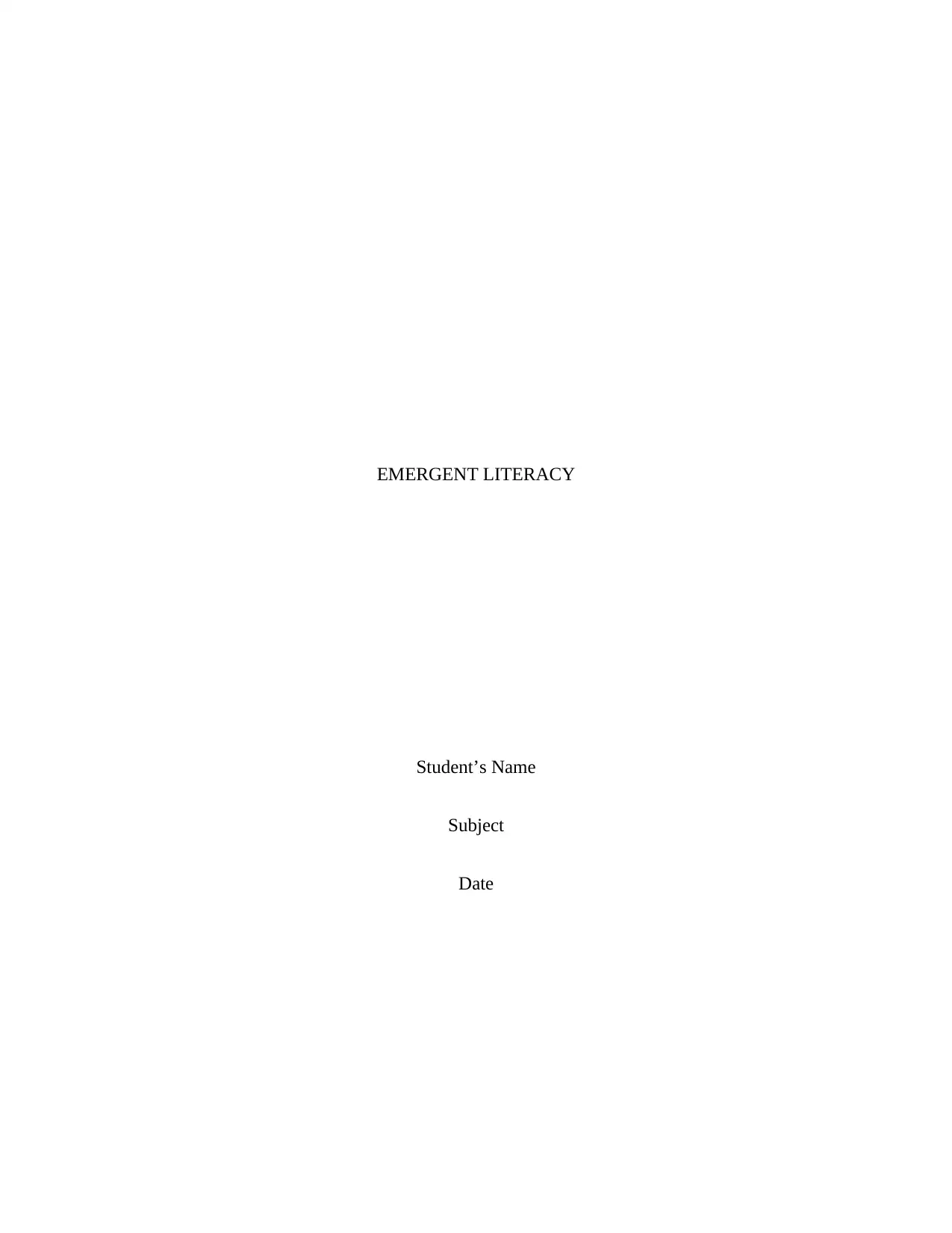
EMERGENT LITERACY
Student’s Name
Subject
Date
Student’s Name
Subject
Date
Secure Best Marks with AI Grader
Need help grading? Try our AI Grader for instant feedback on your assignments.
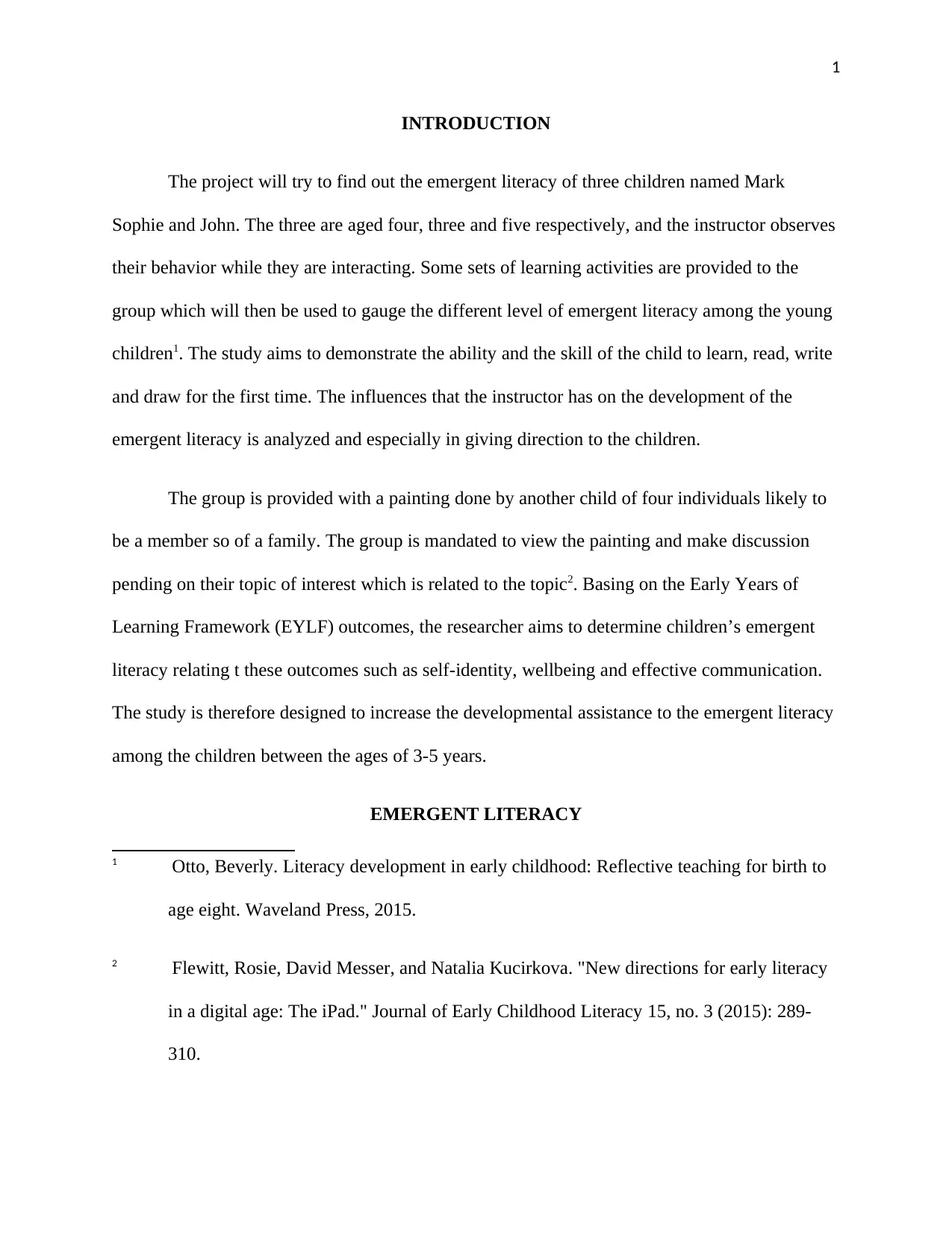
1
INTRODUCTION
The project will try to find out the emergent literacy of three children named Mark
Sophie and John. The three are aged four, three and five respectively, and the instructor observes
their behavior while they are interacting. Some sets of learning activities are provided to the
group which will then be used to gauge the different level of emergent literacy among the young
children1. The study aims to demonstrate the ability and the skill of the child to learn, read, write
and draw for the first time. The influences that the instructor has on the development of the
emergent literacy is analyzed and especially in giving direction to the children.
The group is provided with a painting done by another child of four individuals likely to
be a member so of a family. The group is mandated to view the painting and make discussion
pending on their topic of interest which is related to the topic2. Basing on the Early Years of
Learning Framework (EYLF) outcomes, the researcher aims to determine children’s emergent
literacy relating t these outcomes such as self-identity, wellbeing and effective communication.
The study is therefore designed to increase the developmental assistance to the emergent literacy
among the children between the ages of 3-5 years.
EMERGENT LITERACY
1 Otto, Beverly. Literacy development in early childhood: Reflective teaching for birth to
age eight. Waveland Press, 2015.
2 Flewitt, Rosie, David Messer, and Natalia Kucirkova. "New directions for early literacy
in a digital age: The iPad." Journal of Early Childhood Literacy 15, no. 3 (2015): 289-
310.
INTRODUCTION
The project will try to find out the emergent literacy of three children named Mark
Sophie and John. The three are aged four, three and five respectively, and the instructor observes
their behavior while they are interacting. Some sets of learning activities are provided to the
group which will then be used to gauge the different level of emergent literacy among the young
children1. The study aims to demonstrate the ability and the skill of the child to learn, read, write
and draw for the first time. The influences that the instructor has on the development of the
emergent literacy is analyzed and especially in giving direction to the children.
The group is provided with a painting done by another child of four individuals likely to
be a member so of a family. The group is mandated to view the painting and make discussion
pending on their topic of interest which is related to the topic2. Basing on the Early Years of
Learning Framework (EYLF) outcomes, the researcher aims to determine children’s emergent
literacy relating t these outcomes such as self-identity, wellbeing and effective communication.
The study is therefore designed to increase the developmental assistance to the emergent literacy
among the children between the ages of 3-5 years.
EMERGENT LITERACY
1 Otto, Beverly. Literacy development in early childhood: Reflective teaching for birth to
age eight. Waveland Press, 2015.
2 Flewitt, Rosie, David Messer, and Natalia Kucirkova. "New directions for early literacy
in a digital age: The iPad." Journal of Early Childhood Literacy 15, no. 3 (2015): 289-
310.
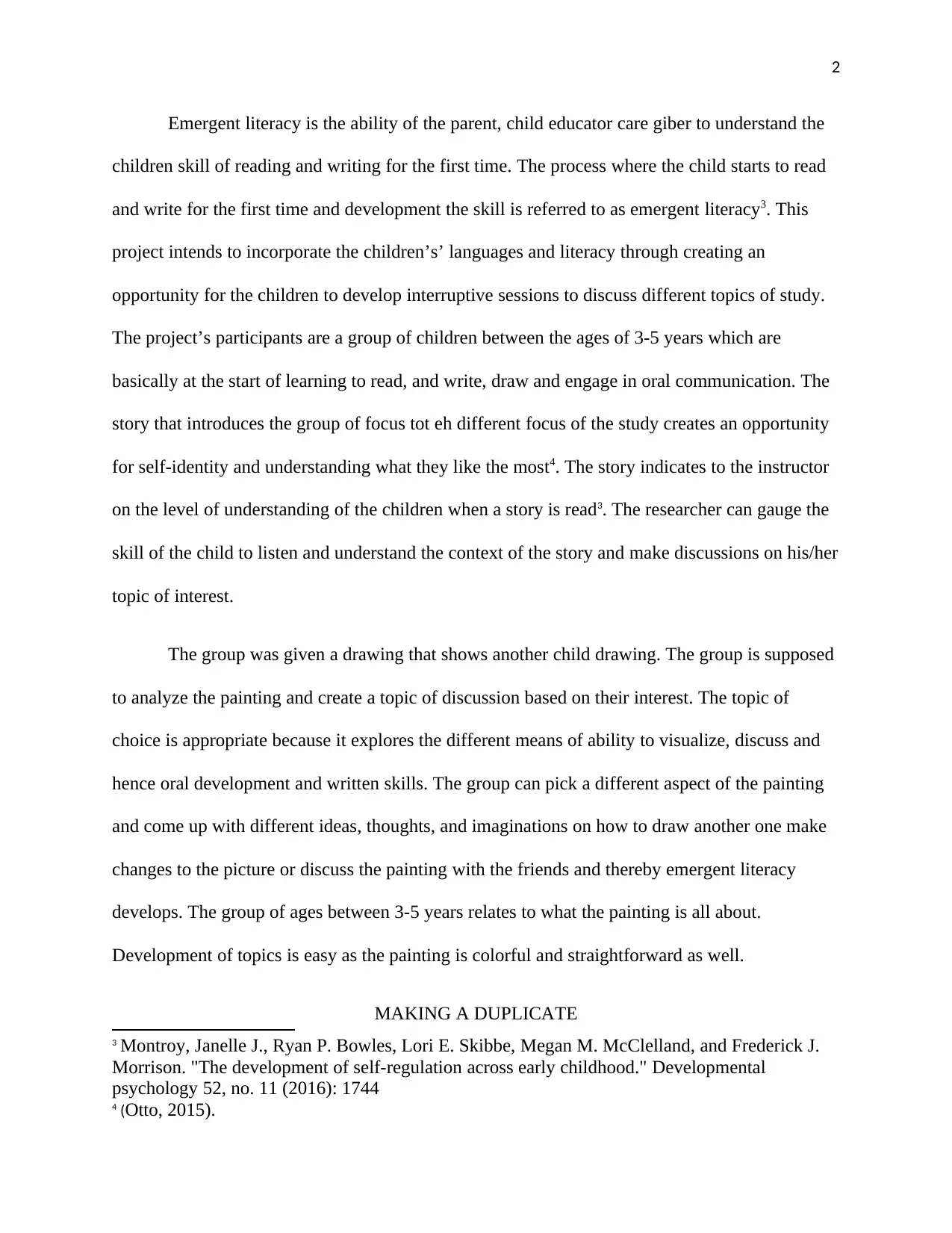
2
Emergent literacy is the ability of the parent, child educator care giber to understand the
children skill of reading and writing for the first time. The process where the child starts to read
and write for the first time and development the skill is referred to as emergent literacy3. This
project intends to incorporate the children’s’ languages and literacy through creating an
opportunity for the children to develop interruptive sessions to discuss different topics of study.
The project’s participants are a group of children between the ages of 3-5 years which are
basically at the start of learning to read, and write, draw and engage in oral communication. The
story that introduces the group of focus tot eh different focus of the study creates an opportunity
for self-identity and understanding what they like the most4. The story indicates to the instructor
on the level of understanding of the children when a story is read3. The researcher can gauge the
skill of the child to listen and understand the context of the story and make discussions on his/her
topic of interest.
The group was given a drawing that shows another child drawing. The group is supposed
to analyze the painting and create a topic of discussion based on their interest. The topic of
choice is appropriate because it explores the different means of ability to visualize, discuss and
hence oral development and written skills. The group can pick a different aspect of the painting
and come up with different ideas, thoughts, and imaginations on how to draw another one make
changes to the picture or discuss the painting with the friends and thereby emergent literacy
develops. The group of ages between 3-5 years relates to what the painting is all about.
Development of topics is easy as the painting is colorful and straightforward as well.
MAKING A DUPLICATE
3 Montroy, Janelle J., Ryan P. Bowles, Lori E. Skibbe, Megan M. McClelland, and Frederick J.
Morrison. "The development of self-regulation across early childhood." Developmental
psychology 52, no. 11 (2016): 1744
4 (Otto, 2015).
Emergent literacy is the ability of the parent, child educator care giber to understand the
children skill of reading and writing for the first time. The process where the child starts to read
and write for the first time and development the skill is referred to as emergent literacy3. This
project intends to incorporate the children’s’ languages and literacy through creating an
opportunity for the children to develop interruptive sessions to discuss different topics of study.
The project’s participants are a group of children between the ages of 3-5 years which are
basically at the start of learning to read, and write, draw and engage in oral communication. The
story that introduces the group of focus tot eh different focus of the study creates an opportunity
for self-identity and understanding what they like the most4. The story indicates to the instructor
on the level of understanding of the children when a story is read3. The researcher can gauge the
skill of the child to listen and understand the context of the story and make discussions on his/her
topic of interest.
The group was given a drawing that shows another child drawing. The group is supposed
to analyze the painting and create a topic of discussion based on their interest. The topic of
choice is appropriate because it explores the different means of ability to visualize, discuss and
hence oral development and written skills. The group can pick a different aspect of the painting
and come up with different ideas, thoughts, and imaginations on how to draw another one make
changes to the picture or discuss the painting with the friends and thereby emergent literacy
develops. The group of ages between 3-5 years relates to what the painting is all about.
Development of topics is easy as the painting is colorful and straightforward as well.
MAKING A DUPLICATE
3 Montroy, Janelle J., Ryan P. Bowles, Lori E. Skibbe, Megan M. McClelland, and Frederick J.
Morrison. "The development of self-regulation across early childhood." Developmental
psychology 52, no. 11 (2016): 1744
4 (Otto, 2015).
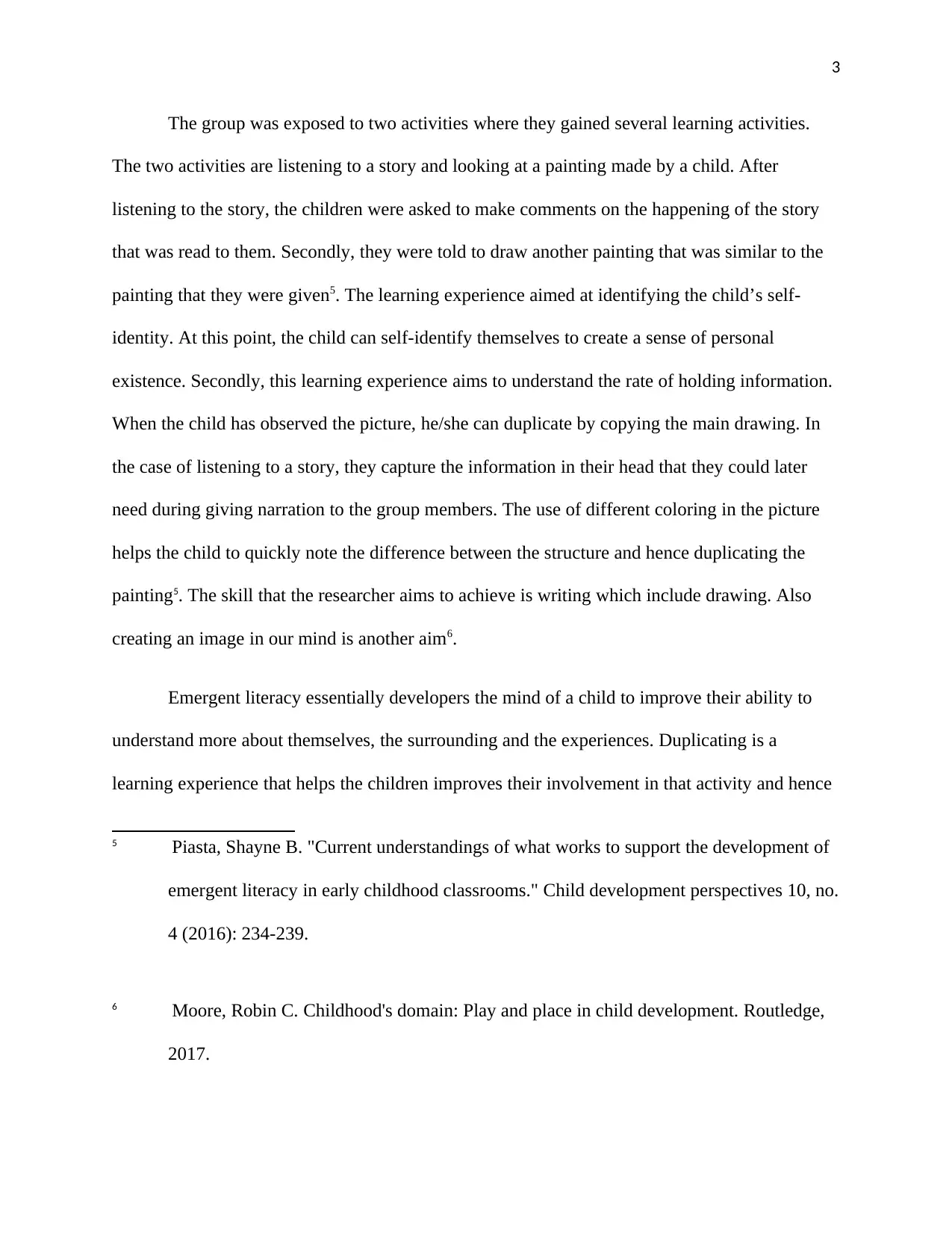
3
The group was exposed to two activities where they gained several learning activities.
The two activities are listening to a story and looking at a painting made by a child. After
listening to the story, the children were asked to make comments on the happening of the story
that was read to them. Secondly, they were told to draw another painting that was similar to the
painting that they were given5. The learning experience aimed at identifying the child’s self-
identity. At this point, the child can self-identify themselves to create a sense of personal
existence. Secondly, this learning experience aims to understand the rate of holding information.
When the child has observed the picture, he/she can duplicate by copying the main drawing. In
the case of listening to a story, they capture the information in their head that they could later
need during giving narration to the group members. The use of different coloring in the picture
helps the child to quickly note the difference between the structure and hence duplicating the
painting5. The skill that the researcher aims to achieve is writing which include drawing. Also
creating an image in our mind is another aim6.
Emergent literacy essentially developers the mind of a child to improve their ability to
understand more about themselves, the surrounding and the experiences. Duplicating is a
learning experience that helps the children improves their involvement in that activity and hence
5 Piasta, Shayne B. "Current understandings of what works to support the development of
emergent literacy in early childhood classrooms." Child development perspectives 10, no.
4 (2016): 234-239.
6 Moore, Robin C. Childhood's domain: Play and place in child development. Routledge,
2017.
The group was exposed to two activities where they gained several learning activities.
The two activities are listening to a story and looking at a painting made by a child. After
listening to the story, the children were asked to make comments on the happening of the story
that was read to them. Secondly, they were told to draw another painting that was similar to the
painting that they were given5. The learning experience aimed at identifying the child’s self-
identity. At this point, the child can self-identify themselves to create a sense of personal
existence. Secondly, this learning experience aims to understand the rate of holding information.
When the child has observed the picture, he/she can duplicate by copying the main drawing. In
the case of listening to a story, they capture the information in their head that they could later
need during giving narration to the group members. The use of different coloring in the picture
helps the child to quickly note the difference between the structure and hence duplicating the
painting5. The skill that the researcher aims to achieve is writing which include drawing. Also
creating an image in our mind is another aim6.
Emergent literacy essentially developers the mind of a child to improve their ability to
understand more about themselves, the surrounding and the experiences. Duplicating is a
learning experience that helps the children improves their involvement in that activity and hence
5 Piasta, Shayne B. "Current understandings of what works to support the development of
emergent literacy in early childhood classrooms." Child development perspectives 10, no.
4 (2016): 234-239.
6 Moore, Robin C. Childhood's domain: Play and place in child development. Routledge,
2017.
Secure Best Marks with AI Grader
Need help grading? Try our AI Grader for instant feedback on your assignments.
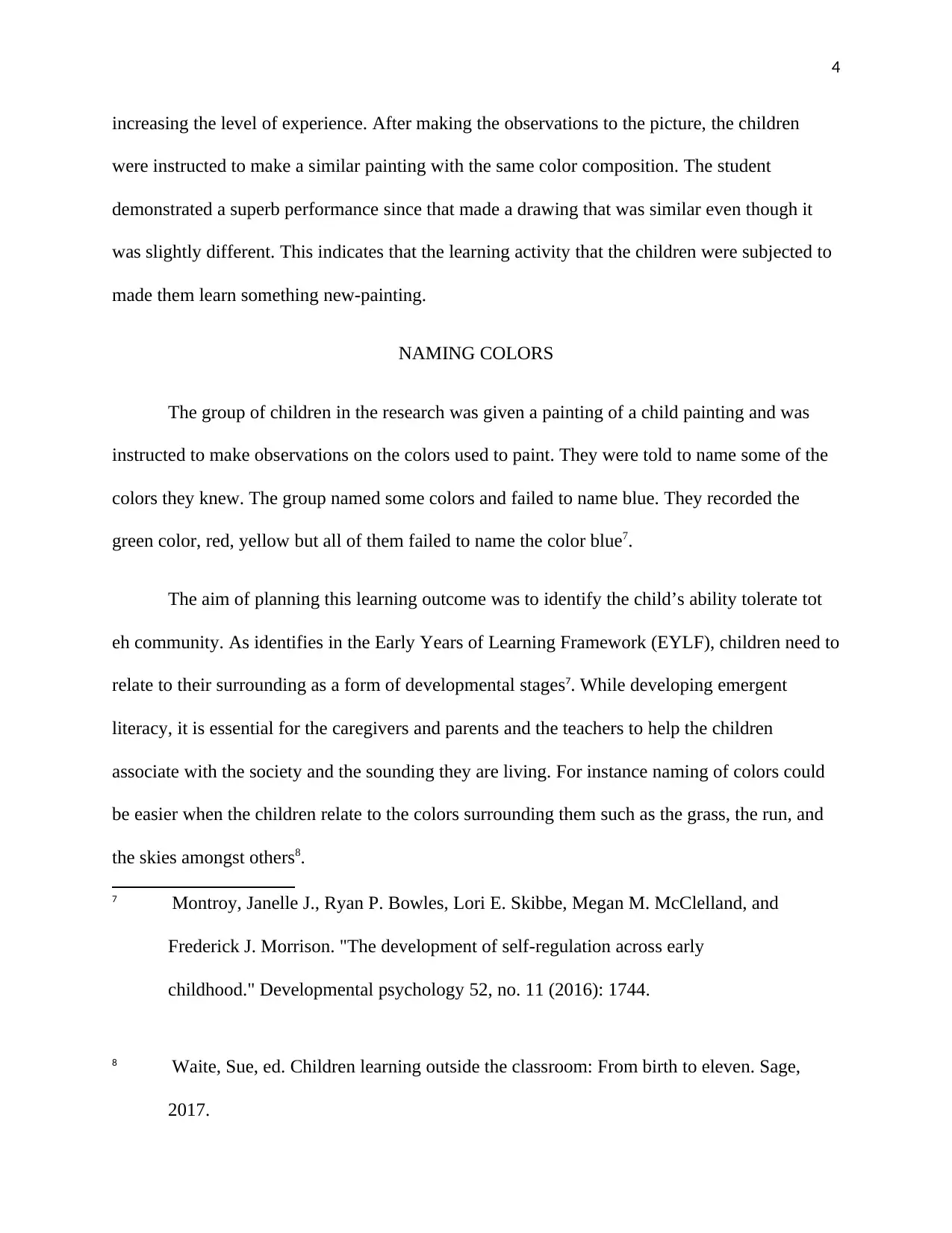
4
increasing the level of experience. After making the observations to the picture, the children
were instructed to make a similar painting with the same color composition. The student
demonstrated a superb performance since that made a drawing that was similar even though it
was slightly different. This indicates that the learning activity that the children were subjected to
made them learn something new-painting.
NAMING COLORS
The group of children in the research was given a painting of a child painting and was
instructed to make observations on the colors used to paint. They were told to name some of the
colors they knew. The group named some colors and failed to name blue. They recorded the
green color, red, yellow but all of them failed to name the color blue7.
The aim of planning this learning outcome was to identify the child’s ability tolerate tot
eh community. As identifies in the Early Years of Learning Framework (EYLF), children need to
relate to their surrounding as a form of developmental stages7. While developing emergent
literacy, it is essential for the caregivers and parents and the teachers to help the children
associate with the society and the sounding they are living. For instance naming of colors could
be easier when the children relate to the colors surrounding them such as the grass, the run, and
the skies amongst others8.
7 Montroy, Janelle J., Ryan P. Bowles, Lori E. Skibbe, Megan M. McClelland, and
Frederick J. Morrison. "The development of self-regulation across early
childhood." Developmental psychology 52, no. 11 (2016): 1744.
8 Waite, Sue, ed. Children learning outside the classroom: From birth to eleven. Sage,
2017.
increasing the level of experience. After making the observations to the picture, the children
were instructed to make a similar painting with the same color composition. The student
demonstrated a superb performance since that made a drawing that was similar even though it
was slightly different. This indicates that the learning activity that the children were subjected to
made them learn something new-painting.
NAMING COLORS
The group of children in the research was given a painting of a child painting and was
instructed to make observations on the colors used to paint. They were told to name some of the
colors they knew. The group named some colors and failed to name blue. They recorded the
green color, red, yellow but all of them failed to name the color blue7.
The aim of planning this learning outcome was to identify the child’s ability tolerate tot
eh community. As identifies in the Early Years of Learning Framework (EYLF), children need to
relate to their surrounding as a form of developmental stages7. While developing emergent
literacy, it is essential for the caregivers and parents and the teachers to help the children
associate with the society and the sounding they are living. For instance naming of colors could
be easier when the children relate to the colors surrounding them such as the grass, the run, and
the skies amongst others8.
7 Montroy, Janelle J., Ryan P. Bowles, Lori E. Skibbe, Megan M. McClelland, and
Frederick J. Morrison. "The development of self-regulation across early
childhood." Developmental psychology 52, no. 11 (2016): 1744.
8 Waite, Sue, ed. Children learning outside the classroom: From birth to eleven. Sage,
2017.
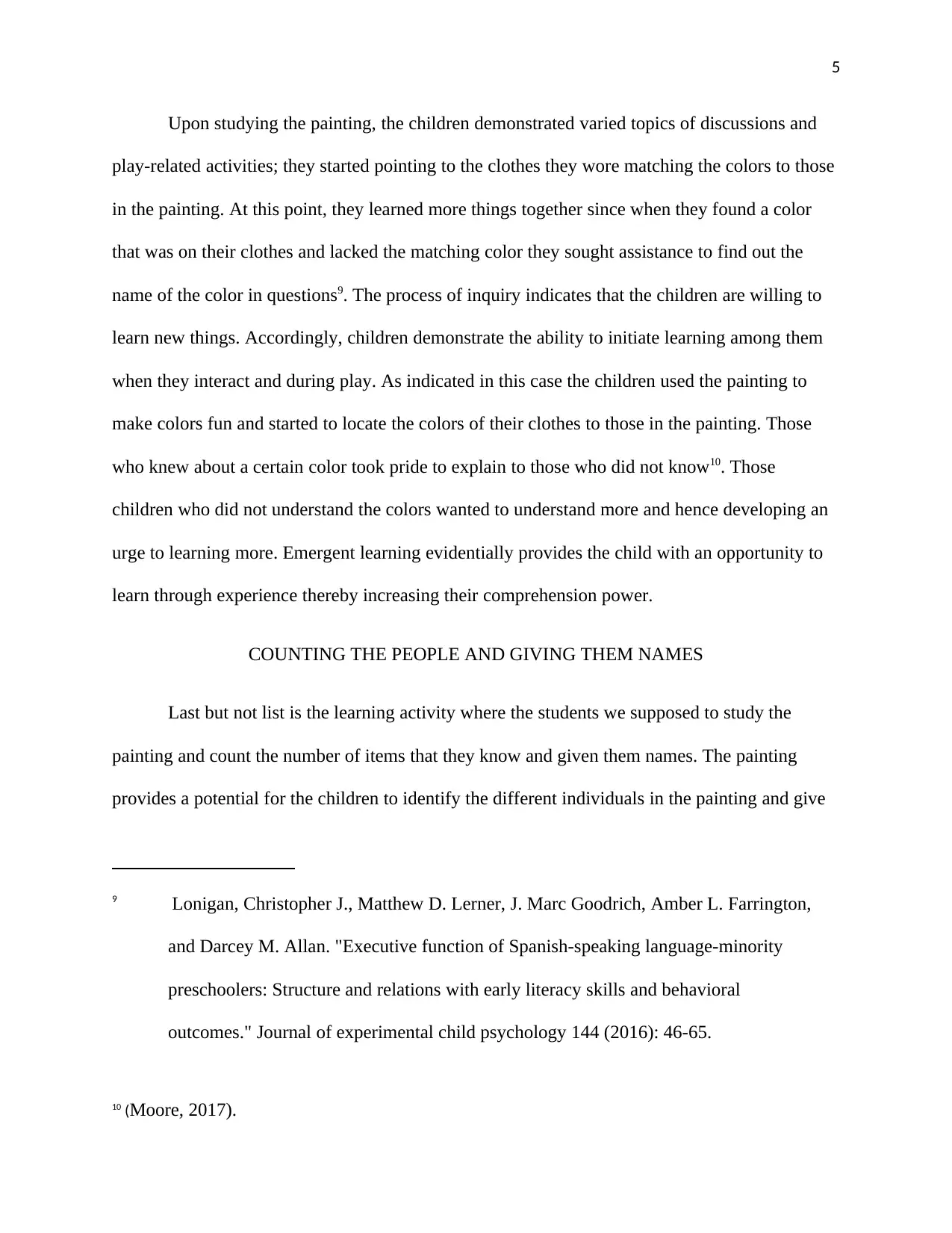
5
Upon studying the painting, the children demonstrated varied topics of discussions and
play-related activities; they started pointing to the clothes they wore matching the colors to those
in the painting. At this point, they learned more things together since when they found a color
that was on their clothes and lacked the matching color they sought assistance to find out the
name of the color in questions9. The process of inquiry indicates that the children are willing to
learn new things. Accordingly, children demonstrate the ability to initiate learning among them
when they interact and during play. As indicated in this case the children used the painting to
make colors fun and started to locate the colors of their clothes to those in the painting. Those
who knew about a certain color took pride to explain to those who did not know10. Those
children who did not understand the colors wanted to understand more and hence developing an
urge to learning more. Emergent learning evidentially provides the child with an opportunity to
learn through experience thereby increasing their comprehension power.
COUNTING THE PEOPLE AND GIVING THEM NAMES
Last but not list is the learning activity where the students we supposed to study the
painting and count the number of items that they know and given them names. The painting
provides a potential for the children to identify the different individuals in the painting and give
9 Lonigan, Christopher J., Matthew D. Lerner, J. Marc Goodrich, Amber L. Farrington,
and Darcey M. Allan. "Executive function of Spanish-speaking language-minority
preschoolers: Structure and relations with early literacy skills and behavioral
outcomes." Journal of experimental child psychology 144 (2016): 46-65.
10 (Moore, 2017).
Upon studying the painting, the children demonstrated varied topics of discussions and
play-related activities; they started pointing to the clothes they wore matching the colors to those
in the painting. At this point, they learned more things together since when they found a color
that was on their clothes and lacked the matching color they sought assistance to find out the
name of the color in questions9. The process of inquiry indicates that the children are willing to
learn new things. Accordingly, children demonstrate the ability to initiate learning among them
when they interact and during play. As indicated in this case the children used the painting to
make colors fun and started to locate the colors of their clothes to those in the painting. Those
who knew about a certain color took pride to explain to those who did not know10. Those
children who did not understand the colors wanted to understand more and hence developing an
urge to learning more. Emergent learning evidentially provides the child with an opportunity to
learn through experience thereby increasing their comprehension power.
COUNTING THE PEOPLE AND GIVING THEM NAMES
Last but not list is the learning activity where the students we supposed to study the
painting and count the number of items that they know and given them names. The painting
provides a potential for the children to identify the different individuals in the painting and give
9 Lonigan, Christopher J., Matthew D. Lerner, J. Marc Goodrich, Amber L. Farrington,
and Darcey M. Allan. "Executive function of Spanish-speaking language-minority
preschoolers: Structure and relations with early literacy skills and behavioral
outcomes." Journal of experimental child psychology 144 (2016): 46-65.
10 (Moore, 2017).
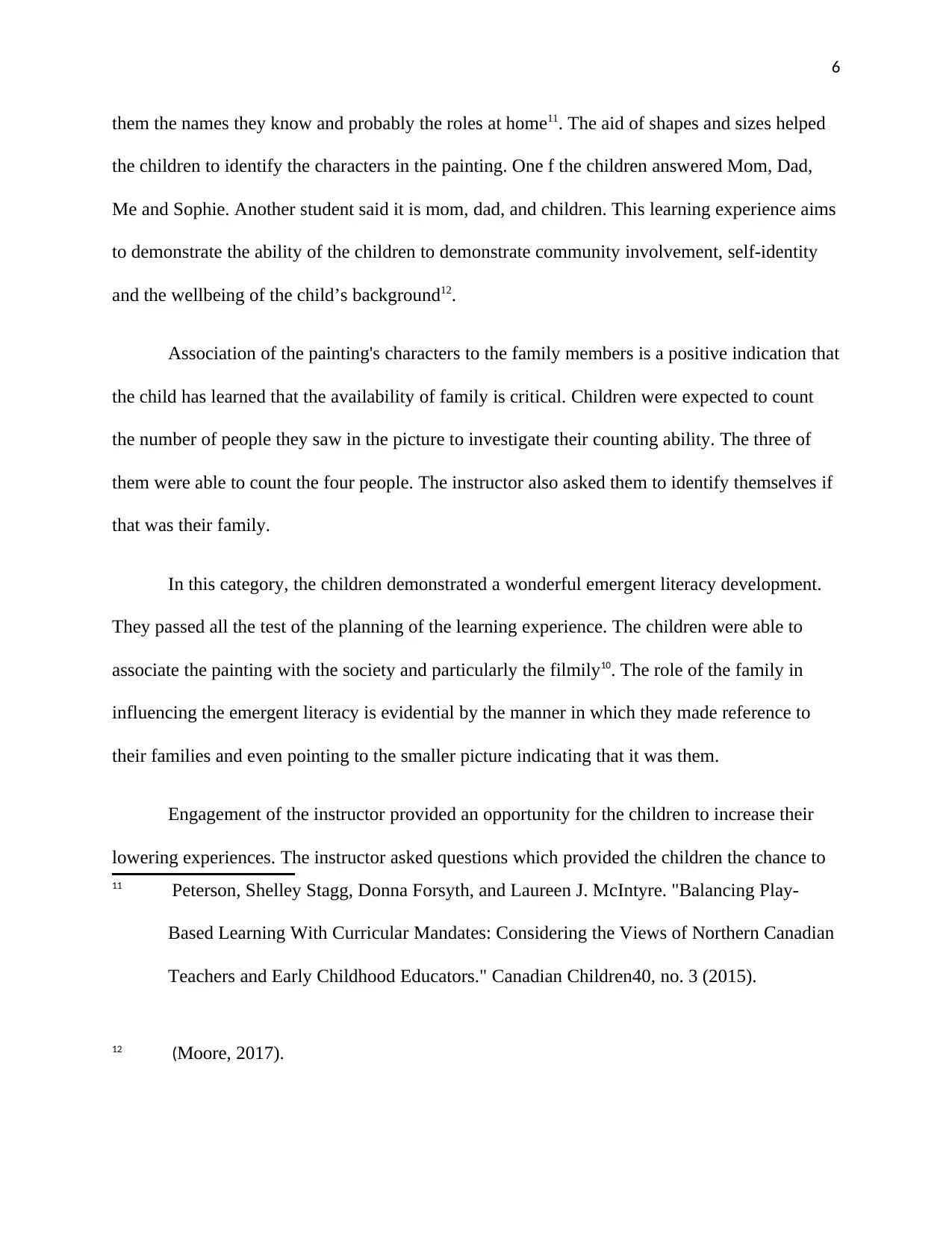
6
them the names they know and probably the roles at home11. The aid of shapes and sizes helped
the children to identify the characters in the painting. One f the children answered Mom, Dad,
Me and Sophie. Another student said it is mom, dad, and children. This learning experience aims
to demonstrate the ability of the children to demonstrate community involvement, self-identity
and the wellbeing of the child’s background12.
Association of the painting's characters to the family members is a positive indication that
the child has learned that the availability of family is critical. Children were expected to count
the number of people they saw in the picture to investigate their counting ability. The three of
them were able to count the four people. The instructor also asked them to identify themselves if
that was their family.
In this category, the children demonstrated a wonderful emergent literacy development.
They passed all the test of the planning of the learning experience. The children were able to
associate the painting with the society and particularly the filmily10. The role of the family in
influencing the emergent literacy is evidential by the manner in which they made reference to
their families and even pointing to the smaller picture indicating that it was them.
Engagement of the instructor provided an opportunity for the children to increase their
lowering experiences. The instructor asked questions which provided the children the chance to
11 Peterson, Shelley Stagg, Donna Forsyth, and Laureen J. McIntyre. "Balancing Play-
Based Learning With Curricular Mandates: Considering the Views of Northern Canadian
Teachers and Early Childhood Educators." Canadian Children40, no. 3 (2015).
12 (Moore, 2017).
them the names they know and probably the roles at home11. The aid of shapes and sizes helped
the children to identify the characters in the painting. One f the children answered Mom, Dad,
Me and Sophie. Another student said it is mom, dad, and children. This learning experience aims
to demonstrate the ability of the children to demonstrate community involvement, self-identity
and the wellbeing of the child’s background12.
Association of the painting's characters to the family members is a positive indication that
the child has learned that the availability of family is critical. Children were expected to count
the number of people they saw in the picture to investigate their counting ability. The three of
them were able to count the four people. The instructor also asked them to identify themselves if
that was their family.
In this category, the children demonstrated a wonderful emergent literacy development.
They passed all the test of the planning of the learning experience. The children were able to
associate the painting with the society and particularly the filmily10. The role of the family in
influencing the emergent literacy is evidential by the manner in which they made reference to
their families and even pointing to the smaller picture indicating that it was them.
Engagement of the instructor provided an opportunity for the children to increase their
lowering experiences. The instructor asked questions which provided the children the chance to
11 Peterson, Shelley Stagg, Donna Forsyth, and Laureen J. McIntyre. "Balancing Play-
Based Learning With Curricular Mandates: Considering the Views of Northern Canadian
Teachers and Early Childhood Educators." Canadian Children40, no. 3 (2015).
12 (Moore, 2017).
Paraphrase This Document
Need a fresh take? Get an instant paraphrase of this document with our AI Paraphraser
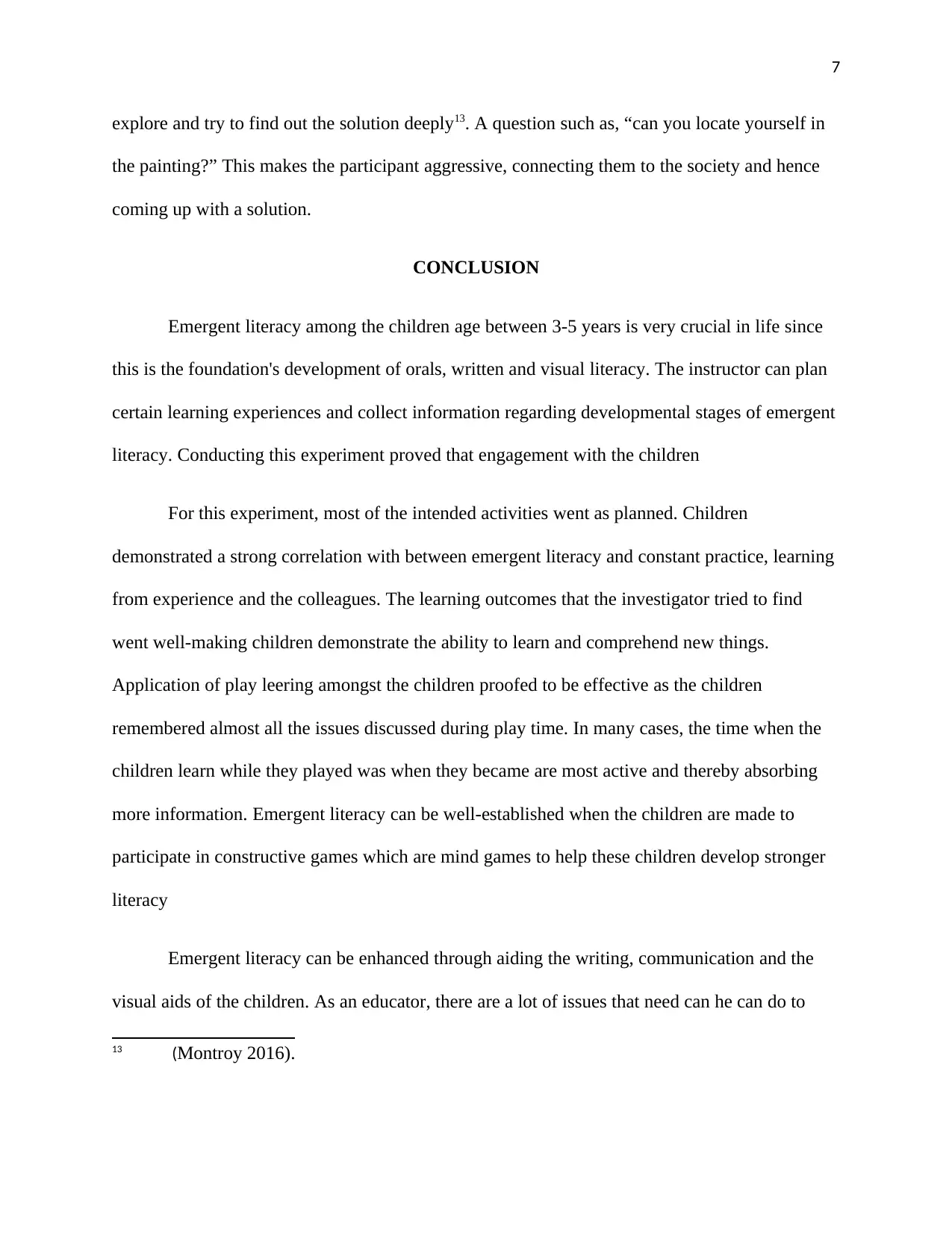
7
explore and try to find out the solution deeply13. A question such as, “can you locate yourself in
the painting?” This makes the participant aggressive, connecting them to the society and hence
coming up with a solution.
CONCLUSION
Emergent literacy among the children age between 3-5 years is very crucial in life since
this is the foundation's development of orals, written and visual literacy. The instructor can plan
certain learning experiences and collect information regarding developmental stages of emergent
literacy. Conducting this experiment proved that engagement with the children
For this experiment, most of the intended activities went as planned. Children
demonstrated a strong correlation with between emergent literacy and constant practice, learning
from experience and the colleagues. The learning outcomes that the investigator tried to find
went well-making children demonstrate the ability to learn and comprehend new things.
Application of play leering amongst the children proofed to be effective as the children
remembered almost all the issues discussed during play time. In many cases, the time when the
children learn while they played was when they became are most active and thereby absorbing
more information. Emergent literacy can be well-established when the children are made to
participate in constructive games which are mind games to help these children develop stronger
literacy
Emergent literacy can be enhanced through aiding the writing, communication and the
visual aids of the children. As an educator, there are a lot of issues that need can he can do to
13 (Montroy 2016).
explore and try to find out the solution deeply13. A question such as, “can you locate yourself in
the painting?” This makes the participant aggressive, connecting them to the society and hence
coming up with a solution.
CONCLUSION
Emergent literacy among the children age between 3-5 years is very crucial in life since
this is the foundation's development of orals, written and visual literacy. The instructor can plan
certain learning experiences and collect information regarding developmental stages of emergent
literacy. Conducting this experiment proved that engagement with the children
For this experiment, most of the intended activities went as planned. Children
demonstrated a strong correlation with between emergent literacy and constant practice, learning
from experience and the colleagues. The learning outcomes that the investigator tried to find
went well-making children demonstrate the ability to learn and comprehend new things.
Application of play leering amongst the children proofed to be effective as the children
remembered almost all the issues discussed during play time. In many cases, the time when the
children learn while they played was when they became are most active and thereby absorbing
more information. Emergent literacy can be well-established when the children are made to
participate in constructive games which are mind games to help these children develop stronger
literacy
Emergent literacy can be enhanced through aiding the writing, communication and the
visual aids of the children. As an educator, there are a lot of issues that need can he can do to
13 (Montroy 2016).
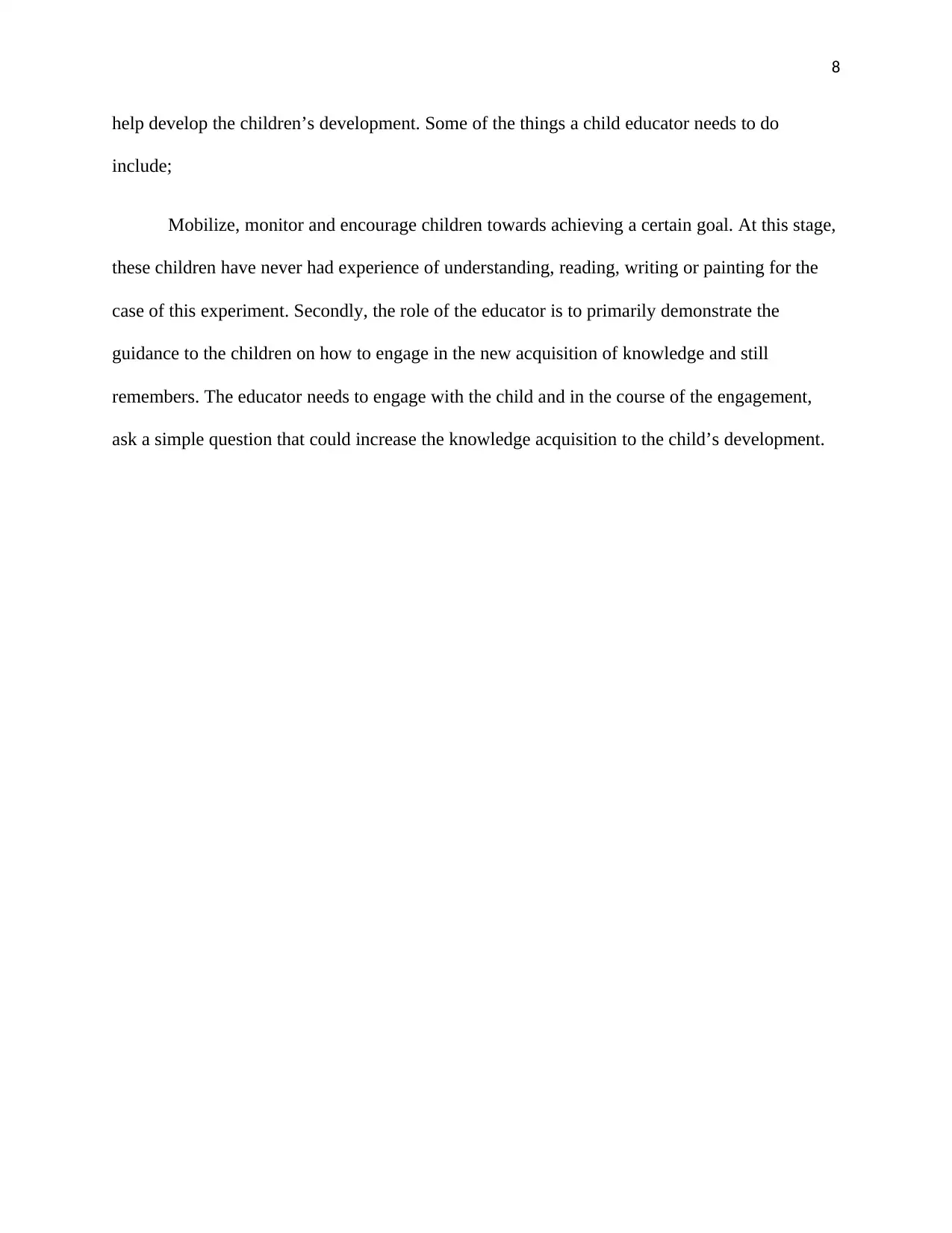
8
help develop the children’s development. Some of the things a child educator needs to do
include;
Mobilize, monitor and encourage children towards achieving a certain goal. At this stage,
these children have never had experience of understanding, reading, writing or painting for the
case of this experiment. Secondly, the role of the educator is to primarily demonstrate the
guidance to the children on how to engage in the new acquisition of knowledge and still
remembers. The educator needs to engage with the child and in the course of the engagement,
ask a simple question that could increase the knowledge acquisition to the child’s development.
help develop the children’s development. Some of the things a child educator needs to do
include;
Mobilize, monitor and encourage children towards achieving a certain goal. At this stage,
these children have never had experience of understanding, reading, writing or painting for the
case of this experiment. Secondly, the role of the educator is to primarily demonstrate the
guidance to the children on how to engage in the new acquisition of knowledge and still
remembers. The educator needs to engage with the child and in the course of the engagement,
ask a simple question that could increase the knowledge acquisition to the child’s development.
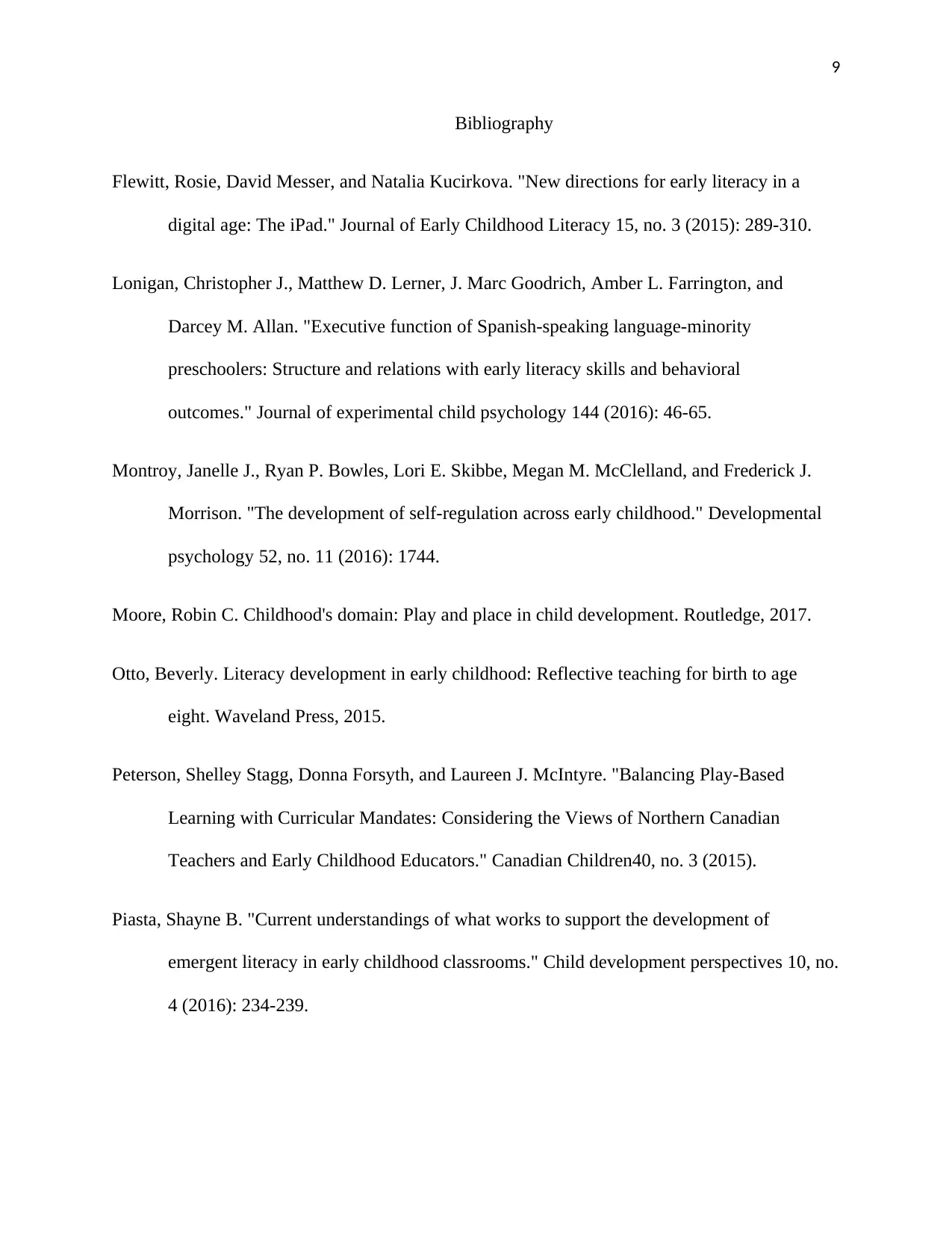
9
Bibliography
Flewitt, Rosie, David Messer, and Natalia Kucirkova. "New directions for early literacy in a
digital age: The iPad." Journal of Early Childhood Literacy 15, no. 3 (2015): 289-310.
Lonigan, Christopher J., Matthew D. Lerner, J. Marc Goodrich, Amber L. Farrington, and
Darcey M. Allan. "Executive function of Spanish-speaking language-minority
preschoolers: Structure and relations with early literacy skills and behavioral
outcomes." Journal of experimental child psychology 144 (2016): 46-65.
Montroy, Janelle J., Ryan P. Bowles, Lori E. Skibbe, Megan M. McClelland, and Frederick J.
Morrison. "The development of self-regulation across early childhood." Developmental
psychology 52, no. 11 (2016): 1744.
Moore, Robin C. Childhood's domain: Play and place in child development. Routledge, 2017.
Otto, Beverly. Literacy development in early childhood: Reflective teaching for birth to age
eight. Waveland Press, 2015.
Peterson, Shelley Stagg, Donna Forsyth, and Laureen J. McIntyre. "Balancing Play-Based
Learning with Curricular Mandates: Considering the Views of Northern Canadian
Teachers and Early Childhood Educators." Canadian Children40, no. 3 (2015).
Piasta, Shayne B. "Current understandings of what works to support the development of
emergent literacy in early childhood classrooms." Child development perspectives 10, no.
4 (2016): 234-239.
Bibliography
Flewitt, Rosie, David Messer, and Natalia Kucirkova. "New directions for early literacy in a
digital age: The iPad." Journal of Early Childhood Literacy 15, no. 3 (2015): 289-310.
Lonigan, Christopher J., Matthew D. Lerner, J. Marc Goodrich, Amber L. Farrington, and
Darcey M. Allan. "Executive function of Spanish-speaking language-minority
preschoolers: Structure and relations with early literacy skills and behavioral
outcomes." Journal of experimental child psychology 144 (2016): 46-65.
Montroy, Janelle J., Ryan P. Bowles, Lori E. Skibbe, Megan M. McClelland, and Frederick J.
Morrison. "The development of self-regulation across early childhood." Developmental
psychology 52, no. 11 (2016): 1744.
Moore, Robin C. Childhood's domain: Play and place in child development. Routledge, 2017.
Otto, Beverly. Literacy development in early childhood: Reflective teaching for birth to age
eight. Waveland Press, 2015.
Peterson, Shelley Stagg, Donna Forsyth, and Laureen J. McIntyre. "Balancing Play-Based
Learning with Curricular Mandates: Considering the Views of Northern Canadian
Teachers and Early Childhood Educators." Canadian Children40, no. 3 (2015).
Piasta, Shayne B. "Current understandings of what works to support the development of
emergent literacy in early childhood classrooms." Child development perspectives 10, no.
4 (2016): 234-239.
Secure Best Marks with AI Grader
Need help grading? Try our AI Grader for instant feedback on your assignments.
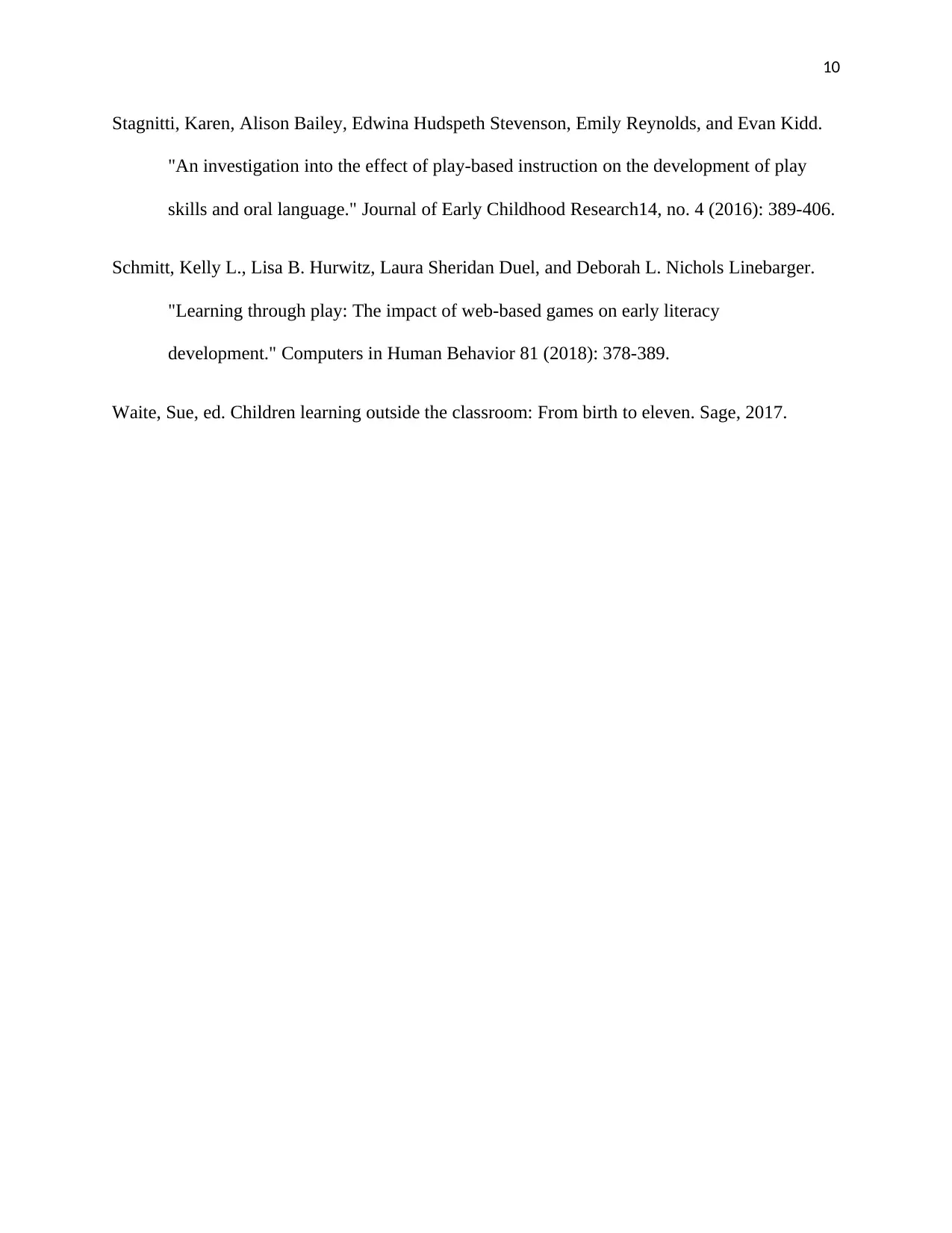
10
Stagnitti, Karen, Alison Bailey, Edwina Hudspeth Stevenson, Emily Reynolds, and Evan Kidd.
"An investigation into the effect of play-based instruction on the development of play
skills and oral language." Journal of Early Childhood Research14, no. 4 (2016): 389-406.
Schmitt, Kelly L., Lisa B. Hurwitz, Laura Sheridan Duel, and Deborah L. Nichols Linebarger.
"Learning through play: The impact of web-based games on early literacy
development." Computers in Human Behavior 81 (2018): 378-389.
Waite, Sue, ed. Children learning outside the classroom: From birth to eleven. Sage, 2017.
Stagnitti, Karen, Alison Bailey, Edwina Hudspeth Stevenson, Emily Reynolds, and Evan Kidd.
"An investigation into the effect of play-based instruction on the development of play
skills and oral language." Journal of Early Childhood Research14, no. 4 (2016): 389-406.
Schmitt, Kelly L., Lisa B. Hurwitz, Laura Sheridan Duel, and Deborah L. Nichols Linebarger.
"Learning through play: The impact of web-based games on early literacy
development." Computers in Human Behavior 81 (2018): 378-389.
Waite, Sue, ed. Children learning outside the classroom: From birth to eleven. Sage, 2017.
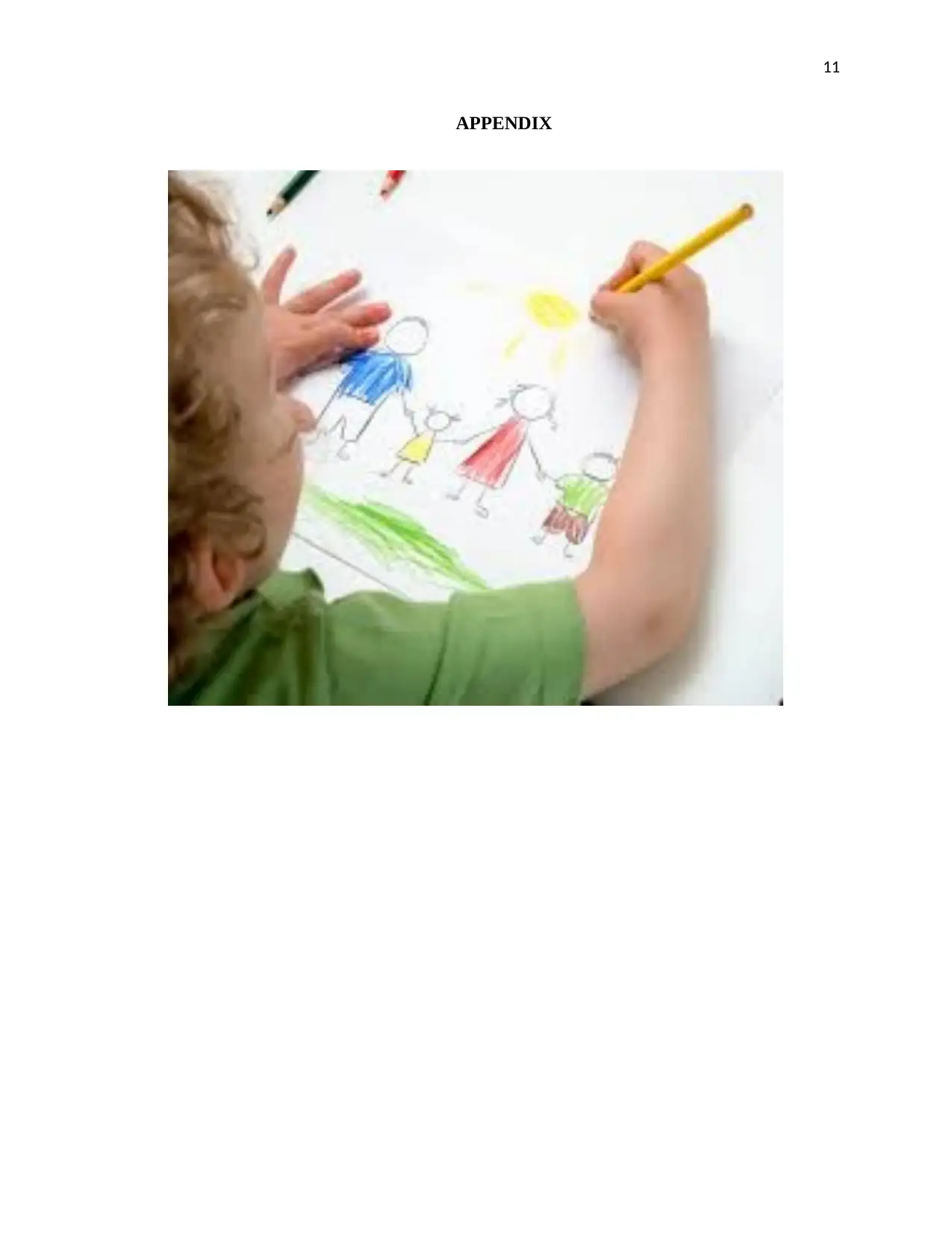
11
APPENDIX
APPENDIX
1 out of 12
Related Documents
Your All-in-One AI-Powered Toolkit for Academic Success.
+13062052269
info@desklib.com
Available 24*7 on WhatsApp / Email
![[object Object]](/_next/static/media/star-bottom.7253800d.svg)
Unlock your academic potential
© 2024 | Zucol Services PVT LTD | All rights reserved.





